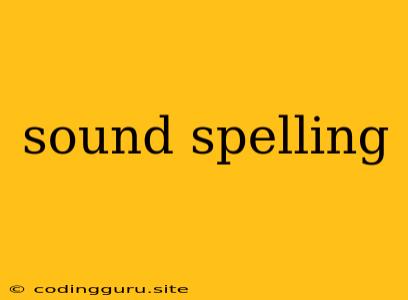The Art of Sound Spelling: How We Translate Speech into Writing
Have you ever wondered how we go from the sounds we hear to the letters we see on a page? It's a process we take for granted, but sound spelling, or phonetic transcription, is a fascinating and complex aspect of language. This article explores the nuances of sound spelling, highlighting its importance in communication and learning.
What is Sound Spelling?
Sound spelling, also known as phonetic transcription, is the representation of spoken language using symbols. These symbols, known as phonemes, represent individual sounds rather than letters. This system is crucial for understanding how language works, particularly for learners of new languages or those who need to learn pronunciation.
Why is Sound Spelling Important?
Sound spelling plays a vital role in various aspects of language:
-
Language Learning: Phonetic transcription helps learners understand the pronunciation of words and how sounds are produced. This is especially helpful for learners of languages with different spelling systems, like English, where pronunciation can be unpredictable.
-
Speech Therapy: Sound spelling is essential for speech therapists who analyze and treat speech disorders. It helps identify and categorize mispronunciations and develop appropriate interventions.
-
Linguistic Research: Linguists use sound spelling to analyze and compare different languages, identifying patterns and variations in pronunciation and sound systems.
-
Dictionaries and Textbooks: Many dictionaries and textbooks include phonetic transcriptions to provide accurate pronunciation guidance.
How is Sound Spelling Used?
Sound spelling is widely used in various forms:
-
International Phonetic Alphabet (IPA): The IPA is a universal system of phonetic transcription used by linguists and phoneticians to represent all known sounds of human speech. Each sound has its own symbol, making it a precise and consistent method for recording and transcribing speech.
-
Simplified Transcription Systems: Other sound spelling systems use a simplified set of symbols, often based on the English alphabet, for representing speech sounds. These systems are often used for educational purposes or in language learning materials.
Challenges in Sound Spelling
While sound spelling offers valuable tools for communication and understanding, it also presents challenges:
-
Variability in Pronunciation: Different dialects and accents can influence the way sounds are pronounced, making it difficult to create a universally accepted sound spelling system.
-
Complex Sound Systems: Some languages have complex sound systems, requiring more detailed phonetic transcription and more symbols to represent them accurately.
-
Ambiguity in Letters: Some letters in the English alphabet can represent multiple sounds, leading to inconsistencies and potential confusion in sound spelling.
Tips for Understanding Sound Spelling
-
Focus on Sound: When learning sound spelling, focus on the actual sounds you hear rather than the letters themselves.
-
Use Audio Resources: Listen to recordings of native speakers to hear how sounds are produced and practice mimicking those sounds.
-
Practice Regularly: Consistent practice is crucial for developing accurate sound spelling skills.
-
Consult Reliable Sources: Refer to dictionaries, textbooks, or online resources that provide phonetic transcriptions for clarification and guidance.
Conclusion
Sound spelling, or phonetic transcription, is a powerful tool for understanding and representing speech. From language learning to linguistic research, sound spelling plays a crucial role in communication and knowledge sharing. By embracing the nuances of sound spelling, we gain deeper insights into the intricacies of language and its ability to connect us all.
